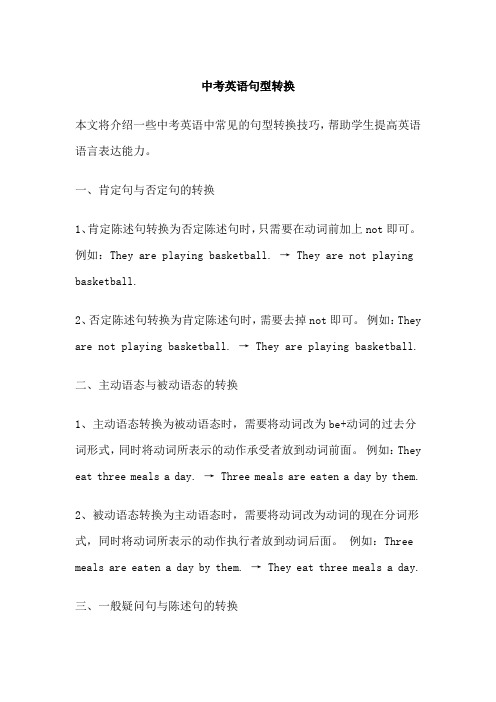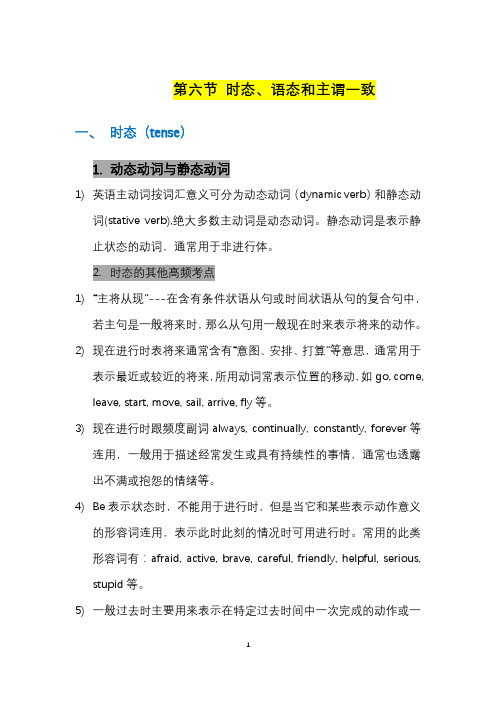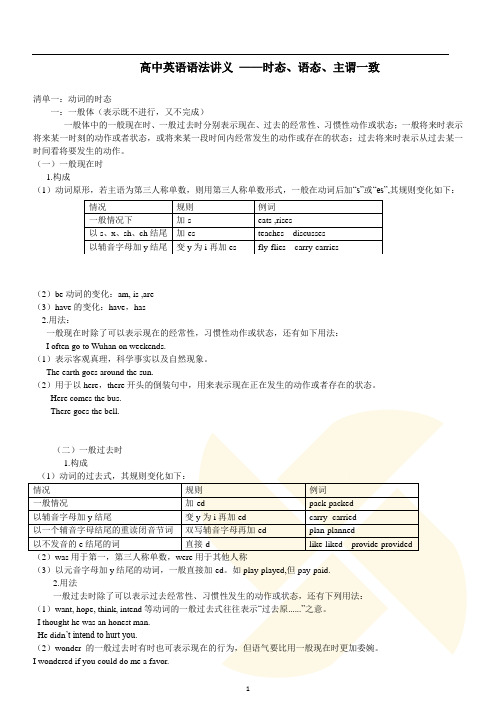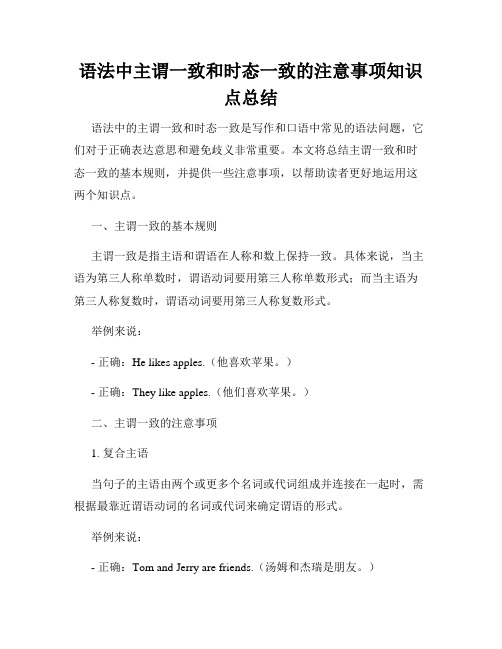状语从句。主谓一致。几种时态转换
中考英语句型转换

中考英语句型转换本文将介绍一些中考英语中常见的句型转换技巧,帮助学生提高英语语言表达能力。
一、肯定句与否定句的转换1、肯定陈述句转换为否定陈述句时,只需要在动词前加上not即可。
例如:They are playing basketball. → They are not playing basketball.2、否定陈述句转换为肯定陈述句时,需要去掉not即可。
例如:They are not playing basketball. → They are playing basketball.二、主动语态与被动语态的转换1、主动语态转换为被动语态时,需要将动词改为be+动词的过去分词形式,同时将动词所表示的动作承受者放到动词前面。
例如:They eat three meals a day. → Three meals are eaten a day by them.2、被动语态转换为主动语态时,需要将动词改为动词的现在分词形式,同时将动词所表示的动作执行者放到动词后面。
例如:Three meals are eaten a day by them. → They eat three meals a day.三、一般疑问句与陈述句的转换1、一般疑问句转换为陈述句时,需要将动词改为相应的陈述语气,同时将主语放到动词后面。
例如:Are they playing basketball? →They are playing basketball.2、陈述句转换为一般疑问句时,需要将动词改为一般疑问语气,同时将主语放到动词前面。
例如:They are playing basketball. →Are they playing basketball?四、时间状语从句的转换1、现在时态的时间状语从句转换为过去时态的时间状语从句时,需要将动词改为过去时态。
例如:I will go to the park tomorrow. → I went to the park yesterday.2、过去时态的时间状语从句转换为现在时态的时间状语从句时,需要将动词改为现在时态。
高中英语知识点归纳主谓一致和动词时态的关系

高中英语知识点归纳主谓一致和动词时态的关系高中英语知识点归纳:主谓一致和动词时态的关系一、引言英语是一门语法比较复杂的语言,学习英语需要掌握许多语法知识。
其中,主谓一致和动词时态是最基本的知识点之一。
理解主谓一致和动词时态之间的关系对于正确运用英语语法和表达意思至关重要。
本文将归纳总结高中英语中关于主谓一致和动词时态的相关知识点,以帮助学生提升英语语法能力。
二、主谓一致基本概念主谓一致是指主语与谓语在人称和数上保持一致。
简单来说,如果主语是单数第三人称,则谓语动词要用单数形式;如果主语是复数或非第三人称,则谓语动词要用复数形式。
以下是一些常见的主谓一致规则:1. 单数主语加-s或-es:He goes to school every day.2. 复数主语不加-s或-es:They go to school every day.3. 连系动词后的主语用复数形式:My family are all going to the party.三、动词时态基本概念动词时态表示动作或状态发生的时间。
英语中有多种时态,包括一般现在时、一般过去时、一般将来时等等。
掌握动词时态对于正确表达过去、现在或将来的动作至关重要。
以下是一些常见的动词时态规则:1. 一般现在时:表示经常性或普遍性的动作或状态。
常常使用动词原形:She often goes to the park.2. 一般过去时:表示过去某个时间发生的动作或状态。
常常使用动词的过去式:I watched a movie yesterday.3. 一般将来时:表示将要发生的动作或状态。
常常使用助动词will 加动词原形:They will go to the beach tomorrow.四、主谓一致和动词时态的关系主谓一致和动词时态在英语语法中有密切联系。
具体来说,主谓一致和动词时态的关系可以总结如下:1. 一般现在时的主谓一致:在一般现在时中,单数主语使用第三人称,谓语动词要加-s或-es。
2024年新高考版英语主谓一致、虚拟语气、省略、倒装、强调讲解部分

“a number of+复数名词”作主 A number of other plants were
语时,谓语动词用复数形式,意为 found in America.在美洲还发现
“许多……”;“the number of+ 了许多其他的植物。
复数名词”作主语时,谓语动词 The number of people who travel
复合不定代词someone、anyone、everyone、nobody/no one、something、anything、everything、nothing等作主语时,谓语动词用单数
If anyone sees Lisa, ask her to call me.如果有人看 到莉萨,请她给我打个电话。 Nothing is impossible to a willing heart.世上无难 事,只怕有心人。
If he shouldn't come tomorrow, we would put off the meeting.如果他 明天不来,我们就推迟 这个会议。
使用“(should+)动词原形”的虚拟语气 1.用于宾语从句 以下动词后的宾语从句常常使用虚拟语气,即谓语为“(should+)动词原 形”。
原则
意义 一致
课标必备点梳理
常见用法
例句
当“几分之几/百分之几/half/ the rest/most+of+名词”结构作 主语时,一般根据of后的名词的 单复数决定谓语动词的单复数
20% of the people in the city object to the price of running water going up. 这个城市中百分之二十的人反 对自来水价格上调。
高中英语 动词的时态、语态和主谓一致精讲

(3)表示人的“观点” “看法” “建议” “态 度” “评价”等词、“活动的目的”以及客观 事实时,常用一般现在时。
A good medicine __t_a_s_te_s__(taste) bitter. Our geography teacher told us that the earth __g_o_es_(go) around the sun.
2
(2)用于状语从句代替一般将来时 在when , as soon as , before , after , until , if 等引 导的时间状语或条件状语从句,谓语动词是将来 时通常用一般现在时代替。 “主将从现”
If he succeeds(succeed), he will be the hero of human beings.
Terry and his wife were tidying up their new home busilyw_h_e_n_ the light suddenly went out.
I was about to go out w__h_e_n the telephone rang.
9
6.现在完成时 构成形式: 助动词have/has + 动词的过去分词
4
2.一般过去时 构成形式 did
表示过去某一时间点发生的动作或所处的状态.
注意:一般过去时往往和明确的过去时间状语连 用.如: yesterday, last night, two days (months, weeks) ago, in 1996, the other day也常和when, if 等 引导的状语从句连用.
10
So far, it has turned (turn) the most influential student activity in the world.
22版:谓语动词的时态、语态和主谓一致(创新设计)

动词(短语)表示主语的动作、存在、变化或态度。
动词按照动词的意义可以分为实义动词、情态动词、系动词、助动词。
谓语动词的时态、语态和主谓一致动词时态历来是高考考查的重点。
动词时态考查虽多,但考向非常集中,最常考的是一般过去时和一般现在时,其次是现在完成时,其他时态考查相对较少。
因此备考重点是:①动词时态的基本用法②动词语态的基本用法③主谓一致动词时态的知识网络(以动词do为例)1.一般时态(1)一般现在时①表示经常或习惯性的动作,多用动作动词,且常与表频率的时间状语连用。
We have meals three times a day.我们一日吃三餐。
②表示客观真理、科学事实及自然现象。
The sun sets in the west.太阳从西方落下。
③在时间、条件状语从句中常用一般现在时代替一般将来时。
I’ll write to her when I have time.有时间我会写信给她。
(2)一般过去时①表示过去发生的一次性或习惯性动作或状态。
We often played basketball together.我们(过去)经常在一起打篮球。
②时间、条件、让步状语从句中,若主句用了过去将来时,从句常用一般过去时。
He said he would tell her the news as soon as he met her.他说他一见到她就把这个消息告诉她。
单句语法填空①The 80,000 objects collected by Sir Hans Sloane, for example, formed (form) the core collection of the British Museum which/that opened in 1759.(2020·新高考卷Ⅰ语法填空)②The unmanned Chang’e-4 probe (探测器)—the name was inspired by an ancient Chinese moon goddess—touched (touch) down last week in the South Pole-Aitken basin.(2020·全国卷Ⅰ语法填空)③When/As he asked the villagers on the banks of the river where he could find the legendary (传奇的) artist, they smiled and pointed (point) down the river.(2020·全国卷Ⅲ语法填空)④New methods meant__(mean)that fewer people worked in farming.(2020·浙江卷语法填空)⑤While running regularly can’t make you live forever,the review says it is(be) more effective at lengthening life than walking,cycling or swimming.(2018·全国卷Ⅰ语法填空)⑥Sarah says,“My dad thinks I should take the offer now.But at the moment,school comes (come) first.I don’t want to get too absorbed in modeling.”(全国卷Ⅲ语法填空)2.进行时态(1)现在进行时(am/is/are+现在分词)①表示说话时正在进行或发生的动作,也可表示现阶段正在进行的动作或存在的状态。
专四语法之时态、语态和主谓一致

第六节时态、语态和主谓一致一、时态(tense)1.动态动词与静态动词1)英语主动词按词汇意义可分为动态动词(dynamic verb)和静态动词(stative verb),绝大多数主动词是动态动词。
静态动词是表示静止状态的动词,通常用于非进行体。
2.时态的其他高频考点1)“主将从现”---在含有条件状语从句或时间状语从句的复合句中,若主句是一般将来时,那么从句用一般现在时来表示将来的动作。
2)现在进行时表将来通常含有“意图、安排、打算”等意思,通常用于表示最近或较近的将来,所用动词常表示位置的移动,如go, come, leave, start, move, sail, arrive, fly等。
3)现在进行时跟频度副词always, continually, constantly, forever等连用,一般用于描述经常发生或具有持续性的事情,通常也透露出不满或抱怨的情绪等。
4)Be表示状态时,不能用于进行时,但是当它和某些表示动作意义的形容词连用,表示此时此刻的情况时可用进行时。
常用的此类形容词有:afraid, active, brave, careful, friendly, helpful, serious, stupid等。
5)一般过去时主要用来表示在特定过去时间中一次完成的动作或一度存在的状态。
一般过去时还可用在特定句型中表示现在时间和将来时间,表示委婉语气,这一用法仅限want, wonder, hope, think 等少数几个动词。
6)将来进行时表示的是在将来某一时间正在进行的动作,常表示安排好的事,给人一种期待之感。
也可表示预料不久要发生的动作,由shall/will+ be+ v.-ing构成。
7)将来完成时表示将来某时刻之前或某一行为发生之前所完成的动作,也可用于在谈及未来的假设和可能的推测时。
由will/ shall+ have+过去分词构成。
8)现在完成进行时,用来表示一个动作从过去某时开始,一直延续到说话时还在继续或刚刚结束,由have/ has+ been+ v.-ing构成。
高中英语语法讲义 ——时态、语态、主谓一致

高中英语语法讲义——时态、语态、主谓一致清单一:动词的时态一:一般体(表示既不进行,又不完成)一般体中的一般现在时、一般过去时分别表示现在、过去的经常性、习惯性动作或状态;一般将来时表示将来某一时刻的动作或者状态,或将来某一段时间内经常发生的动作或存在的状态;过去将来时表示从过去某一时间看将要发生的动作。
(一)一般现在时1.构成(1)动词原形,若主语为第三人称单数,则用第三人称单数形式,一般在动词后加“s”或“es”,其规则变化如下:情况规则例词一般情况下加-s eats ,rises以s、x、sh、ch结尾加-es teaches discusses以辅音字母加y结尾变y为i再加es fly-flies carry-carries(2)be动词的变化:am, is ,are(3)have的变化:have,has2.用法:一般现在时除了可以表示现在的经常性,习惯性动作或状态,还有如下用法:I often go to Wuhan on weekends.(1)表示客观真理,科学事实以及自然现象。
The earth goes around the sun.(2)用于以here,there开头的倒装句中,用来表示现在正在发生的动作或者存在的状态。
Here comes the bus.There goes the bell.(二)一般过去时1.构成情况规则例词一般情况加-ed pack-packed以辅音字母加y结尾变y为i再加ed carry- carried以一个辅音字母结尾的重读闭音节词双写辅音字母再加-ed plan-planned以不发音的e结尾的词直接-d like-liked provide-provided(2)was用于第一,第三人称单数,were用于其他人称(3)以元音字母加y结尾的动词,一般直接加-ed。
如play-played,但pay-paid.2.用法一般过去时除了可以表示过去经常性、习惯性发生的动作或状态,还有下列用法:(1)want, hope, think, intend等动词的一般过去式往往表示“过去原......”之意。
时态、语态、倒装、主谓一致

感谢您的观看
THANKS
时态、语态、倒装、 主谓一致
目录
CONTENTS
• 时态 • 语态 • 倒装 • 主谓一致
01 时态
过去时态
定义
表示过去发生的动作或状态。
例子
I saw the movie last night.
现在时态
定义
表示现在发生的动作或状态。
例子
I am writing a letter.
将来时态
完全倒装
要点一
在强调某个句子成分时,通常使 用完全倒装。例如
On the table lay a book.
要点二
在表示方位或时间的介词短语放 在句首时,也使用完全倒装。…
In the distance was heard the sound of music.
倒装的特殊情况
01
在虚拟语气中,有时使用倒装结 构来强调虚拟语气中的条件或结 果。例如:If only I had known the answer.
倒装结构
在倒装句中,谓语动词的 形式取决于倒装后的主语。
主谓一致的练习题
练习1
The teacher with his students ____(visit) the science museum next week.
01
解析
时间状语next week表明时态为将来 时,主语the teacher with his
students表示复数意义,因此谓语动 词用复数形式will visit。
03
答案
see
05
02
答案
will visit
04
练习2
Either you or one of your students ____(see) the film.
句子的主谓一致和时态(完美版)

句子的主谓一致和时态(完美版)句子的主谓一致和时态(完美版)句子的主谓一致和时态是语法中非常重要的概念。
主谓一致指的是主语和谓语动词在人称和数上保持一致,而时态则表示动作发生的时间。
正确使用主谓一致和时态可以使句子更加准确和流畅。
以下是对主谓一致和时态的详细说明。
主谓一致主谓一致是指句子中的主语和谓语动词在人称和数上保持一致。
具体来说,如果主语是第三人称单数,谓语动词应该使用单数形式;如果主语是第一、第二人称或者复数形式,谓语动词应该使用相应的形式。
以下是一些例子:- 错误例子:The dog barks loudly is the garden.(狗在花园里大声叫。
)- 正确例子:The dog barks loudly in the garden.(狗在花园里大声叫。
)- 错误例子:He eat hamburgers every day.(他每天吃汉堡。
)- 正确例子:He eats hamburgers every day.(他每天吃汉堡。
)- 错误例子:They is going to the movies.(他们要去看电影。
)- 正确例子:They are going to the movies.(他们要去看电影。
)以上例子展示了在简单句中主谓一致的规则。
需要注意的是,有些特殊的主语和谓语动词的组合可能会有例外情况。
在这种情况下,需要根据具体语境和语法规则来确定正确的主谓一致形式。
时态时态指的是动词所表示的动作或状态发生的时间。
英语中常用的时态包括一般现在时、一般过去时、一般将来时等。
选择正确的时态能够帮助读者准确理解句子所传达的信息。
以下是常用时态的例子:- 一般现在时:表示经常性的动作、客观事实或现实情况。
- I eat breakfast every morning.(我每天早上吃早饭。
)- The sun rises in the east.(太阳从东方升起。
)- 一般过去时:表示已经发生的动作或存在的状态。
句子变换改变句子的语序和句型的技巧

句子变换改变句子的语序和句型的技巧句子变换:改变句子的语序和句型的技巧在写作中,通过句子变换可以增加表达的方式,使文章更加丰富多样。
而句子变换的技巧涉及语序和句型的改变,为文章增添灵动性和吸引力。
本文将从不同的角度探讨句子变换的技巧,旨在帮助读者提升写作水平。
一、语序变换1. 倒装结构倒装结构是指将原句的主语和谓语之间的位置进行互换。
一般来说,倒装结构常用于以下几种情况:(1)完全倒装:将助动词、情态动词或be动词放在句首,紧随其后的是主语。
例如:Never have I seen such a beautiful sunset.Rarely does she go to the cinema.(2)部分倒装:将助动词、情态动词或be动词与其后面的其他词组进行倒装。
例如:Not only did he win the competition, but he also broke the record.Only when we face the truth can we find a solution.2. 强调句型强调句型是通过将句子中的某个成分进行强调,以突出该成分的重要性或与其他事物的对比。
在强调句型中,通常会将被强调的部分放在句首,并使用特殊的强调词语。
例如:It was John who won the game.It is the teacher who inspires me to study harder.3. 省略句省略句是在句子中省略掉某些成分或词语,但仍能保持句子的完整和清晰。
通过省略句,可以使句子更加简洁明了。
例如:I like coffee, and she does too.(省略了第二个动词)Mary can play the piano, and her sister can too.(省略了第二个谓语)二、句型变换1. 被动语态通过将主动语态转换为被动语态,可以突出动作的承受者,或在强调客观性、科学性等方面起到作用。
语法中主谓一致和时态一致的注意事项知识点总结

语法中主谓一致和时态一致的注意事项知识点总结语法中的主谓一致和时态一致是写作和口语中常见的语法问题,它们对于正确表达意思和避免歧义非常重要。
本文将总结主谓一致和时态一致的基本规则,并提供一些注意事项,以帮助读者更好地运用这两个知识点。
一、主谓一致的基本规则主谓一致是指主语和谓语在人称和数上保持一致。
具体来说,当主语为第三人称单数时,谓语动词要用第三人称单数形式;而当主语为第三人称复数时,谓语动词要用第三人称复数形式。
举例来说:- 正确:He likes apples.(他喜欢苹果。
)- 正确:They like apples.(他们喜欢苹果。
)二、主谓一致的注意事项1. 复合主语当句子的主语由两个或更多个名词或代词组成并连接在一起时,需根据最靠近谓语动词的名词或代词来确定谓语的形式。
举例来说:- 正确:Tom and Jerry are friends.(汤姆和杰瑞是朋友。
)- 正确:The shopkeeper, as well as his assistants, is responsible for the store's security.(店主和他的助手们都对店铺的安全负责。
)2. 存在从句当句子中有一个从句作为主语时,一般要将谓语的形式与从句中的主语保持一致。
举例来说:- 正确:That she is late is unacceptable.(她迟到是不可接受的。
)- 正确:What he says doesn't make sense.(他说的话没有意义。
)三、时态一致的基本规则时态一致是指句子中的动词要与其所表示的动作或状态的时态保持一致。
1. 一般现在时当句子的主语为第三人称单数时,谓语动词要用一般现在时的第三人称单数形式。
举例来说:- 正确:She works in a hospital.(她在一家医院工作。
)- 正确:The cat often sleeps on the sofa.(那只猫经常在沙发上睡觉。
第三节 主谓一致与时态、语态

第三节主谓一致与时态、语态谓语动词指在句子中充当谓语的动词。
而谓语成分就是用来说明主语的动作或状态的。
实义动词可以独立充当谓语动词;连系动词必须和表语一起充当谓语动词;助动词、情态动词不能单独作谓语,只能协助主要动词一起构成谓语动词。
在中学英语教学中,学生最难掌握的语法项目是什么?学生70%以上的错误都出在了谓语动词变化的环节。
首先,英语句子的谓语会随着句子时态的变化而变化,而在汉语中,动词永远不会有时间上的变化,如果要表现时态,也仅仅就在句子中加入“现在”“刚才”之类的时间词就可以了。
再次,英语谓语动词的变化往往要随着句子主语的变化而变化,而汉语中谓语动词是不会随着主语的变化而变化的,无论主语是单数,复数概念,还是第一、第二、第三人称。
第三,汉语句子的肯定句、疑问句、否定句变化简单。
而英语句子必须通过谓语动词的变化,才能变成肯定句、疑问句、否定句。
最后,英语句子的主动语态和被动语态的变化,也要通过谓语动词变化来实现。
而汉语只需要使用“被”字就可以。
总之,任何一个句子中的谓语动词,都包含着主谓一致、时态、语态、语气等这几方面变化的信息。
写出或者说出任何一个英语句子,都要考虑这几个方面的情况。
稍有不慎,就会出现错误。
掌握了谓语动词的变化规则,就意味着突破了英语语法学习的瓶颈。
一、主谓一致主谓一致是指:(1)语法形式上要一致,即主语单复数与谓语的单复数形式要一致。
(2)意义上要一致,即主语意义上的单复数要与谓语的单复数形式一致。
(3)就近原则,即谓语动二、时态时是时间,即谓语动词发生的时间可分为现在、过去、将来和过去将来等四种时间形式;态是形态,即谓语动词发生的方式,可分为一般、进行、完成和完成进行等四种形式。
高中三、语态语态是动词的一种形式,用来说明主语和谓语动词之间的关系。
英语动词有两种语态,即主动语态和被动语态。
主动语态表示主语是谓语动词动作的执行者;被动语态表示主语是谓语动词动作的承受者。
被动语态是动词的一种特殊形式,一般来说,只有需要动作对象的及物动词才有被动语态,不及物动词没有被动语态。
英文写作中的主谓一致和时态变换

英文写作中的主谓一致和时态变换在英文写作中,主谓一致和时态变换是两个重要的语法规则。
正确运用主谓一致和时态变换可以使文章更加流畅和准确。
本文将探讨这两个语法规则的基本概念和运用技巧。
主谓一致是指主语和谓语在人称和数上保持一致。
即当主语是单数第三人称时,谓语动词要使用单数形式;当主语是复数或单数第一、第二人称时,谓语动词要使用复数形式。
例如,“He runs every morning.”中,主语是单数第三人称“He”,谓语动词“run”使用了单数形式。
主谓一致的原则也适用于其他形式的谓语,如助动词、情态动词等。
要正确运用主谓一致,需要注意一些特殊情况。
首先,当主语由多个并列成分组成时,谓语动词与最近的主语保持一致。
例如,“John, along with his friends, is going to the party.”中,谓语动词“is”与最近的主语“John”保持一致。
其次,当主谓之间有插入语时,插入语不影响主谓一致。
例如,“The dog, barking loudly, runs after the ball.”中,插入语“barking loudly”不影响谓语动词“runs”的单数形式。
时态变换是指随着时间的推进,动词的形式和用法发生的变化。
在英文写作中,时态的准确运用可以表达事件的发生顺序和持续状态。
常用的时态包括一般现在时、一般过去时、一般将来时等。
对于一般现在时,用来表示现在的情况、经常性的动作或普遍真理等。
例如,“He plays basketball every day.”中,谓语动词“plays”表示经常性的动作。
对于一般过去时,用来表示过去的情况或事件。
例如,“She studied hard for the exam.”中,谓语动词“studied”表示过去的动作。
对于一般将来时,用来表示将来的情况或计划。
例如,“I will go shopping tomorrow.”中,谓语动词“will go”表示将来的行为。
主谓一致与状语从句的关系

主谓一致与状语从句的关系主谓一致是英语语法中一个重要的规则,它指的是主语和谓语在人称和数上要一致。
例如,当主语是第三人称单数时,谓语动词要使用第三人称单数形式。
主谓一致在句子中起到了连接主语和谓语的作用,使得句子更加准确和流畅。
然而,当句子中存在状语从句时,主谓一致的问题就会变得稍微复杂一些。
状语从句是一个修饰主句的从句,用来描述时间、地点、原因、条件、比较等等。
在状语从句中,谓语动词的形式取决于从句中的主语和上下文的要求,而不再受到主句主语的限制。
具体来说,当主句和状语从句的主语一致时,谓语动词的形式要与状语从句的主语保持一致。
例如:1. When she goes to school, she always takes the bus.当她去上学的时候,她总是坐公交车。
这里,主句的主语是she,状语从句的主语也是she。
因此,谓语动词"goes"和"takes"都使用了第三人称单数形式,与主句和从句的主语一致。
然而,当主句和状语从句的主语不一致时,谓语动词的形式将与状语从句的主语一致,而不再受到主句主语的限制。
例如:2. While they were playing football, he was reading a book.当他们在踢足球的时候,他正在看书。
这里,主句的主语是he,状语从句的主语是they。
虽然主句的主语是第三人称单数形式,但是由于状语从句的主语是第三人称复数形式,所以谓语动词"were playing"也采用了第三人称复数形式,与状语从句的主语一致。
在状语从句中,还有一种特殊情况,那就是当从句中的主语是不定式短语时,谓语动词依然采用基本形式(即不加任何词尾)。
例如:3. Before he leaves for work, he likes to have a cup of coffee.在他出门上班之前,他喜欢喝一杯咖啡。
英语语法练习中的主谓一致与时态使用

英语语法练习中的主谓一致与时态使用主谓一致与时态使用是英语语法中非常重要的部分。
它们对于正确表达意思和避免歧义至关重要。
在英语学习过程中,我们经常会遇到这些问题,因此掌握主谓一致和时态使用的规则是非常必要的。
首先,让我们来看看主谓一致的规则。
在英语中,主语和谓语动词必须在人称和数上保持一致。
例如,当主语是第三人称单数时,谓语动词必须加上-s或-es。
例如,"She likes to read books."(她喜欢读书。
)这里,主语"She"是第三人称单数,所以谓语动词"likes"也要加上-s。
然而,有时候主谓一致并不那么简单。
当主语是复数形式时,谓语动词则不需要加上-s。
例如,"They like to play soccer."(他们喜欢踢足球。
)这里,主语"They"是复数形式,所以谓语动词"like"不需要加上-s。
此外,在使用代词时,也要注意主谓一致。
例如,"Everyone loves their own family."(每个人都爱自己的家人。
)这里,代词"their"与前面的主语"Everyone"保持一致,因为"Everyone"是第三人称单数。
接下来,让我们来探讨时态使用的规则。
时态可以用来表达动作发生的时间。
在英语中,常见的时态有现在时、过去时和将来时。
我们需要根据具体情况选择合适的时态。
现在时用来表达现在正在发生的事情、经常性的动作或普遍真理。
例如,"I am studying English."(我正在学习英语。
)这里,"am studying"表达的是现在正在进行的动作。
过去时用来表达过去发生的事情。
例如,"She went to the park yesterday."(她昨天去了公园。
掌握正确使用主谓一致和时态

掌握正确使用主谓一致和时态主谓一致是英语语法中的重要概念,它指的是主语和谓语在人称和数上的一致。
时态则是指表达动作或状态的时间。
正确使用主谓一致和时态是写作中的基本要求,能够使文章更准确地表达意思,增强文章的可读性。
本文将通过几个实例来说明如何掌握正确使用主谓一致和时态。
一、主谓一致主谓一致要求主语和谓语在人称和数上保持一致。
具体来说,当主语是第三人称单数时,谓语动词要加-s或-es。
例如:1. He eats an apple every day.(主语是第三人称单数,谓语动词eat 变为eats)2. The cat sleeps on the sofa.(主语是第三人称单数,谓语动词sleep 变为sleeps)另外,主谓一致也要求在人称和数上保持一致。
例如:1. I am a student.(主语是第一人称单数,谓语动词am保持一致)2. We are students.(主语是第一人称复数,谓语动词are保持一致)二、时态时态是指动词在时间上的表达方式。
主要有一般现在时、一般过去时和一般将来时等。
1. 一般现在时一般现在时用于表达经常性或习惯性的动作或状态,或者现阶段的真实情况。
例如:1. He goes to work by bus every day.(他每天坐公交车去上班。
)2. I live in Beijing.(我住在北京。
)2. 一般过去时一般过去时用于过去发生的动作或状态。
例如:1. They visited the Great Wall last week.(上周他们参观了长城。
)2. She studied English in high school.(她在高中学习英语。
)3. 一般将来时一般将来时用于表达将来要发生的动作或状态。
例如:1. I will go shopping tomorrow.(我明天要去购物。
)2. They are going to travel abroad next month.(他们下个月要出国旅游。
高中语法学习中的重点难点突破与基础巩固

高中语法学习中的重点难点突破与基础巩固语法是语言的重要组成部分,也是学习语言的基础。
在高中语法学习中,学生常常会遇到一些重点难点,需要通过突破来巩固基础。
本文将围绕高中语法学习中的重点难点进行探讨,并提供一些突破和巩固的方法,以帮助学生在语法学习中取得更好的成绩。
一、主谓一致主谓一致是语法学习中的重点难点之一。
在句子中,主语和谓语在人称和数方面必须保持一致。
学生在学习时常常会遇到一些困惑,特别是当主语与谓语之间有插入语、连词、或者是存在复合结构等情况时,更容易出错。
在突破这一难点问题上,学生可以通过以下方法进行巩固:1. 熟悉基本的主谓一致规则,包括单数主语与单数谓语的搭配、复数主语与复数谓语的搭配以及特殊情况下的处理方法。
2. 做大量的练习题,通过实际操作来加深对主谓一致的理解和运用。
3. 注意关注句子中的插入语、连词和复合结构等因素,确保主谓保持一致。
二、时态与语态时态和语态是高中语法学习中的另一个重点难点。
正确的时态和语态的运用,能够使句子的意思更加准确清晰。
但是,在实际运用中,学生往往容易混淆和错误使用不同的时态和语态。
为了突破和巩固这一难点,学生可以尝试以下方法:1. 理解各种时态和语态的用法和含义,比如一般现在时、过去进行时、将来完成时等,以及主动语态和被动语态的区别。
2. 阅读大量的英文文章和文本,多接触各种时态和语态的表达方式。
3. 通过写作来练习时态和语态的运用,将学到的知识应用到实际写作中,逐渐掌握正确的用法。
三、从句与状语从句从句和状语从句是高中语法学习中的另一个重点难点。
从句是句子中具有主谓结构的分句,而状语从句则是充当句子中的状语。
学生在学习这两个部分时,常常会感到困惑,很难正确运用。
为了突破和巩固这一难点,可以采用以下方法:1. 熟悉从句和状语从句的不同类型和用法,包括时间状语从句、条件状语从句、目的状语从句等。
2. 阅读并分析含有从句和状语从句的句子,理解从句和主句之间的逻辑关系。
- 1、下载文档前请自行甄别文档内容的完整性,平台不提供额外的编辑、内容补充、找答案等附加服务。
- 2、"仅部分预览"的文档,不可在线预览部分如存在完整性等问题,可反馈申请退款(可完整预览的文档不适用该条件!)。
- 3、如文档侵犯您的权益,请联系客服反馈,我们会尽快为您处理(人工客服工作时间:9:00-18:30)。
中考英语语法:状语从句时态类型
1、时态说明
1)在时间和条件状语从句中,通常要用一般现在时表示将来意义,不能直接使用将来时态:
I won’t go if it rains tomorrow. 要是明天下雨,我就不去。
(不能用will rain)
2)有时也可见到if you will 这样的说法,但那不是将来时态,而是表示意愿或委婉的请求(此时的will是情态动词):
If you will wait a moment, I’ll fetch the money. 请等一下,我就去拿钱。
2、常见类型
状语从句即指在主从复合句中用作状语的从句。
状语从句根据其用途可分为时间状语从句、地点状语从句、原因状语从句、结果状语从句、目的状语从句、条件状语从句、方式状语从句等:
He was angry because I was late. 他很生气因为我迟到了。
(原因状语从句)
He was so angry that he couldn’t speak. 他气得话都说不出来。
(结果状语从句)
Although he is poor, he’s happy. 虽然穷,但他仍很快乐。
(让步状语从句)
Put it where you can reach it. 把它放在你可以拿到的地方。
(地点状语从句)
Speak clearly so that they may understand you. 讲清楚些,以便他们能理解你。
(目的状从)
中考英语语法复习:主谓语法一致的原则
谓语受主语支配,须和主语在人称和数上保持一致,这叫做主谓一致。
主谓一致一般遵循三条原则:语法一致原则,意义一致原则和就近一致原则。
1. 语法一致的原则
(1)以单数名词或代词,动词不定式短语作主语时,谓语动词要用单数;主语为复数时,谓语用复数,例如:
He goes to school early every morning.
The children are playing outside.
To work hard is necessary for a student.
(2)由and或both……and连接的并列成分作主语时,谓语动词用复数。
例如:Both he and I are right.
Mr Black and Mrs Black have a son called Tom.
但并列主语如果指的是同一人,同一事物或同一概念,谓语动词用单数。
例如:
His teacher and friend is a beautiful girl.
The poet and writer has come.
(3)由and连接的并列单数主语之前如果分别由each, every修饰时,其谓语动词要用单数形式。
例如:
In our country every boy and every girl has the right to receive education.
Each man and each woman is asked to help.
(4)主语是单数时,尽管后面跟有but ,except, besides, with 等介词短语,谓语动词仍用单数。
例如:
The teacher with his students is going to visit the museum.
Nobody but two boys was late for class.
Bread and butter is a daily food in the west.
(5)一些只有复数形式的名词,如people, police, cattle, clothes等作主语时,谓语动词要用复数。
例如:
A lot of people are dancing outside.
The police are looking for lost boy.
(6)由each, some, any, no, every 构成的复合代词作主语时,谓语动词都用单数。
例如:Is everybody ready?
Somebody is using the phone.
(7)有两部分构成的物体的名词,如glasses, shoes, trousers, chopsticks, scissors 等作主语时,谓语动词用复数。
例如:
Where are my shoes? I can’t find them.
Your trousers are dirty. You’d better change them.
如果这类名词前用了a pair of等,则往往用作单数,谓语动词的单复数形式往往取决于pair的单复数形式。
例如:
Here are some new pairs of shoes.
My new pair of socks is on the bed.
初中英语语法几种常见时态的相互转换
一、一般过去时与现在完成时的转换
在现在完成时中,延续性动词能与表示一段时间的状语连用,瞬间动词却不能。
但是,可用别的表达方式:①瞬间动词用于“一段时间+ ago”的一般过去时的句型中;②瞬间动词可改成与之相对应的延续性动词及短语,与一段时间连用;③瞬间动词用于“It is + 一段时间+ since + 一般过去时”的句型中,表示“自从……以来有……时间”的意思,主句一般用it is来代替It has been;④瞬间动词用于“Some time has passed since + 一般过去时”的句型中。
请看:
A. He joined the League two years ago.
B.He has been in the League for two years.
C. It is two years since he joined the League.
D. Two years has passed since he joined the League.
二、一般现在时与现在进行时的转换
在一般现在时中,at加上名词表示“处于某种状态”,如at work(在工作), at school (上学、上课)等。
此短语可与进行时态转换。
请看:
Peter is at work, but Mike is at play.
Peter is working, but Mike is playing.
三、现在进行时与一般将来时的转换
在现在进行时态中go, come, leave, start, arrive等动词常与表示将来的时间状语连用表示将要发生的动作。
如:I am coming, Mum! 意为“我就来,妈妈!”请看:The train is leaving soon.
The train will leave soon.
四、“be going to+动词原形”与“will(shall)+动词原形”结构的转换
“be going to+动词原形”、表示打算、计划要做的事;将来时“will(shall)+动词原形”结构在书面语中,当主语为第一人称时,常用助动词shall。
在口语中,所有人称都可以用will。
请看:
We are going to visit the Great Wall next Sunday.
We shall visit the Great Wall next Sunday.。
